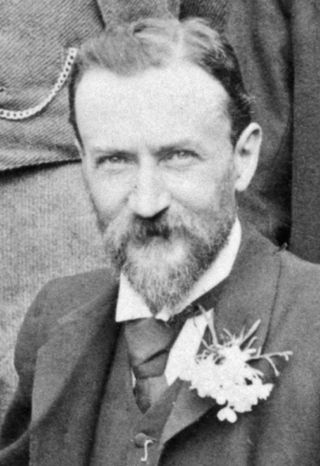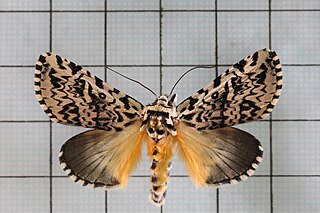Related Research Articles

Arthur Gardiner Butler F.L.S., F.Z.S. was an English entomologist, arachnologist and ornithologist. He worked at the British Museum on the taxonomy of birds, insects, and spiders.
The Tachiniscinae are a subfamily of the fruit fly family Tephritidae. They are treated by some authorities as a separate family, Tachiniscidae. An undetermined species of the genus Tachiniscidia has been reared from Saturniidae caterpillars in Nigeria.
Koyaga is a genus of moths of the family Noctuidae. The genus was described by Ueda in 1984.

Deltote is a genus of moths of the family Noctuidae. The genus was described by Reichenbach in 1817.

Lithacodia is a genus of moths of the family Noctuidae.

Bityla sericea is a species of moth in the family Noctuidae. This species is endemic to New Zealand. It is classified as "At Risk, Naturally Uncommon" by the New Zealand Department of Conservation.

Trichosea champa is a moth of the family Noctuidae first described by Frederic Moore in 1879. It is found in the Himalayas, north-east India, Sri Lanka, China, Taiwan, Japan, and Russia.

Ichneutica plena is a moth of the family Noctuidae. It is endemic to New Zealand. It is widespread throughout the North, South and Stewart Islands. It is a variable in appearance and therefore can be confused with its near relatives I. peridotea and I. insignis. The larvae of I. plena feed on herbaceous plants including Fuchsia excorticata, Coprosma species, and introduced species such as garden fuchsia as well as crops such as apple trees. Adults of this species are on the wing from late August until May.

Lepidoptera Indica was a 10 volume work on the butterflies of the Indian region that was begun in 1890 and completed in 1913. It was published by Lovell Reeve and Co. of London. It has been considered the magnum opus of its author, Frederic Moore, assistant curator at the museum of the East India Company. Frederic Moore described a number of new species through this publication. Moore was a splitter, known for careless creation of synonyms, sometimes placing the same species in more than one genus.

Koyaga virescens is a moth of the family Noctuidae first described by Shigero Sugi in 1958. It is found in Japan and Taiwan.

Pseudodeltote formosana is a species of moth of the family Noctuidae first described by George Hampson in 1910. It is found in Taiwan.
Pseudodeltote brunnea is a species of moth of the family Noctuidae first described by John Henry Leech in 1889. It is found on the Japanese islands of Hokkaido, Honshu, Shikoku and Kyushu.

Pseudodeltote coenia is a species of moth of the family Noctuidae first described by Charles Swinhoe in 1901. It is found in Taiwan.
Protodeltote wiscotti is a species of moth of the family Noctuidae first described by Otto Staudinger in 1888. It is found in the Russian Far East and Japan.
Protodeltote distinguenda is a species of moth of the family Noctuidae first described by Otto Staudinger in 1888. It is found in Korea, Taiwan and Japan.
Protodeltote inexpectata is a species of moth of the family Noctuidae first described by Ueda in 1984. It is found in Japan.
Micardia argentata is a species of moth of the family Noctuidae first described by Arthur Gardiner Butler in 1878. It is found in China, Korea and Japan.
Koyaga falsa is a species of moth of the family Noctuidae first described by Arthur Gardiner Butler in 1885. It is found in China, Korea and Japan.
Koyaga numisma is a species of moth of the family Noctuidae first described by Otto Staudinger in 1888. It is found in Russia, China, Korea and Japan.

Ichneutica morosa is a moth of the family Noctuidae. It is endemic to New Zealand and is found in the southern parts of the North Island and throughout the South Island. I. morosa is common in the eastern parts of both those islands and also in Fiordland. I. morosa can be found from altitudes ranging from lowlands to the alpine zone. I. morosa is absent from the range of its closely related species I. mustulenta, that is from the northern North Island. The larvae of I. morosa are known to feed on Poa astonii and also on other Poa species including introduced species. As well as its standard form the adult moths have a grey colour morph with the head and thorax being a grey and mottled brown, and the forewing being a pale greyish ochreous to a deep brown, suffused with grey. I. morosa can be confused with I. mustulenta and I. lignana. Adults are on the wing from November to April.
References
- 1 2 Ueda, Kyoichiro (March 20, 1987). "A revision of the genus Deltote R. L. and its allied genera from Japan and Taiwan (Lepidoptera: Noctuidae; Acontiinae): Part 2. Systematics of the genus Deltote R. L. and its allied genera" (PDF). Bulletin of the Kitakyushu Museum of Natural History. 6: 41–44.
- ↑ Butler, Arthur G. (1881). "Descriptions of new Genera and Species of Heterocerous Lepidoptera from Japan". Transactions of the Entomological Society of London. 29 (2): 189. doi:10.1111/j.1365-2311.1873.tb01519.x.
- ↑ Hampson, George F. (1910). "Lithacodia senex". Catalogue of the Noctuidae in the Collection of the British Museum. Catalogue of the Lepidoptera Phalaenae in the British Museum. Vol. 10. London: Taylor and Francis. pp. 534–535.